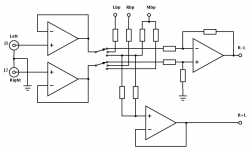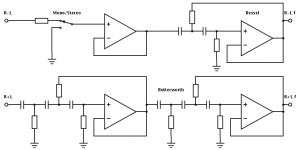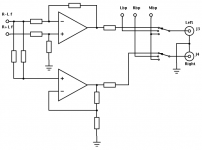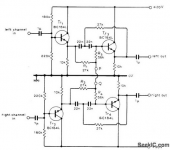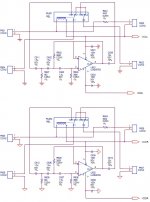I've done a bit more research into filters and am currently coming up with a better way of implementing this concept using an XY configuration with precision resistors to maintain good channel balance. If anyone is interested I'll be posting a schematic within the next couple of weeks. My new design will use the new LME49713 current feedback op-amps so it'll be quite interesting using them for the first time  .
.
I have a lot of old records (mainly LPs) some of which have been warped through poor storage. The rumble and wow&flutter characteristics of my turntables are quite good so I don't think they add to the problem. Some of my records have eccentric spindle holes (the worst is off by about 2mm) that cause frequency modulation of the notes above and below their correct frequencies. I've always assumed that records are recorded with minimal wow&flutter or rumble. The path from original performance to my old records almost certainly included transcription from tape which can add its own warbling effects.
I've read Rod Elliott's (Westhost in Australia) notes on his anti-rumble filter and he comments on "mono-izing" the signal. Mr. Elliott states, "At least one circuit that the I know of uses a method of summing the channels below 140Hz, and although this is effective in removing the low frequency rumble (or sub-rumble in this case) component, it causes frequency response aberrations that (IMO) are not acceptable. The subsonic frequencies generated by record warp are by nature out of phase. The mono component of a vinyl disc is lateral, whereas warp signals are vertical. Stereo signals are at 45° The summing method was examined in great detail before deciding that it should not be used if the overall frequency response of the disc is to be preserved."
KAB (KABUSA) is offering the KAB RF1 HI QUALITY RUMBLE / SUBSONIC FILTER . KAB has this to say about the RF1: "Two important things to know:
1. When records are made, frequencies below about 150Hz are combined to mono. This is done to avoid large out of phase groove excursions.
2. When the stereo stylus moves vertically, the two signals produced are equal and 180 degrees out of phase.
Therefore, below 140Hz, the music is in phase in the lateral stylus motion, and only out of phase noise is found in the vertical stylus motion.
The KAB RF-1 takes advantage of this by electronically combining the left and right channels together below 140Hz. In so doing the filter effectively cancels vertically modulated noise. Vertical rumble comes generally from bearing noise of the disc cutting system. But since the music below 140hz is already mono on the disc, the musical information is unaffected.
Below 20Hz, all signals are quickly attenuated at 18dB/Octave."
Over the years I purchased several items from KAB and have a high level of confidence that they know what they are talking about. I'm a bit conflicted because I also believe that Rod Elliott knows that he is talking about!
In the February 2011 edition of AudioXpress, Jeff Macaulay describes a warp filter. Jeff is famous because, among other things, he designed a rumble filter back in 1978 that appeared as a circuit idea in Wireless World magazine in the UK.
At the moment, I am working on a design that sums L+R to form X (the lateral signal) and takes the difference L-R to form Y (the vertical signal). The X signal is high-pass filtered at 18Hz and the Y signal is high-pass filtered at 140Hz. X and Y are summed to form L and differenced to form R. The summer is a non-inverting design using 1 opamp. The differential amplifier uses 2 opamps. Each HPF uses 2 opamps. I have a couple of projects that are taking up all my hobby time, but as soon I have built and tested it, I'll post the results on DIYAudio.
One important question is what should I compare my rumble/ warp circuit against? The choices are: nothing, Rod Elliott, Michael Fearnley, Jeff Macaulay, and the KAB RF1. I can build all of them except for the KAB. I'll keep you posted.
I've read Rod Elliott's (Westhost in Australia) notes on his anti-rumble filter and he comments on "mono-izing" the signal. Mr. Elliott states, "At least one circuit that the I know of uses a method of summing the channels below 140Hz, and although this is effective in removing the low frequency rumble (or sub-rumble in this case) component, it causes frequency response aberrations that (IMO) are not acceptable. The subsonic frequencies generated by record warp are by nature out of phase. The mono component of a vinyl disc is lateral, whereas warp signals are vertical. Stereo signals are at 45° The summing method was examined in great detail before deciding that it should not be used if the overall frequency response of the disc is to be preserved."
KAB (KABUSA) is offering the KAB RF1 HI QUALITY RUMBLE / SUBSONIC FILTER . KAB has this to say about the RF1: "Two important things to know:
1. When records are made, frequencies below about 150Hz are combined to mono. This is done to avoid large out of phase groove excursions.
2. When the stereo stylus moves vertically, the two signals produced are equal and 180 degrees out of phase.
Therefore, below 140Hz, the music is in phase in the lateral stylus motion, and only out of phase noise is found in the vertical stylus motion.
The KAB RF-1 takes advantage of this by electronically combining the left and right channels together below 140Hz. In so doing the filter effectively cancels vertically modulated noise. Vertical rumble comes generally from bearing noise of the disc cutting system. But since the music below 140hz is already mono on the disc, the musical information is unaffected.
Below 20Hz, all signals are quickly attenuated at 18dB/Octave."
Over the years I purchased several items from KAB and have a high level of confidence that they know what they are talking about. I'm a bit conflicted because I also believe that Rod Elliott knows that he is talking about!
In the February 2011 edition of AudioXpress, Jeff Macaulay describes a warp filter. Jeff is famous because, among other things, he designed a rumble filter back in 1978 that appeared as a circuit idea in Wireless World magazine in the UK.
At the moment, I am working on a design that sums L+R to form X (the lateral signal) and takes the difference L-R to form Y (the vertical signal). The X signal is high-pass filtered at 18Hz and the Y signal is high-pass filtered at 140Hz. X and Y are summed to form L and differenced to form R. The summer is a non-inverting design using 1 opamp. The differential amplifier uses 2 opamps. Each HPF uses 2 opamps. I have a couple of projects that are taking up all my hobby time, but as soon I have built and tested it, I'll post the results on DIYAudio.
One important question is what should I compare my rumble/ warp circuit against? The choices are: nothing, Rod Elliott, Michael Fearnley, Jeff Macaulay, and the KAB RF1. I can build all of them except for the KAB. I'll keep you posted.
Rumble & Warp Filters
Thanks oshifis. You wrote, "I recommend a simpler topology: convert X-Y to M-S, HP filter S (use Bessel filter for minimum group delay), then convert back to X-Y."
What frequency would you suggest for the HPF? If the recording engineers try to record all signals below 140Hz as mono, then I guess the HPF should be tuned to something close to 140Hz. The attenuation down at rumble frequencies would be quite good especially if you used a 4th or 5th order filter.
Would you filter the mono signal? The mono signal should not suffer from warp but will still include some rumble. The consensus seems to be around 18Hz. What do you think?
Thanks oshifis. You wrote, "I recommend a simpler topology: convert X-Y to M-S, HP filter S (use Bessel filter for minimum group delay), then convert back to X-Y."
What frequency would you suggest for the HPF? If the recording engineers try to record all signals below 140Hz as mono, then I guess the HPF should be tuned to something close to 140Hz. The attenuation down at rumble frequencies would be quite good especially if you used a 4th or 5th order filter.
Would you filter the mono signal? The mono signal should not suffer from warp but will still include some rumble. The consensus seems to be around 18Hz. What do you think?
I've been doing a little more experimenting. Butterworth filters chopping the bottom off the side channel cause bumps in the frequency response. Bessel filters do not. I've decided to use a 12dB 150Hz Bessel filter on the side channel and a 36dB 15Hz Butterworth filter on the mid.
Drawing it up right now as a stand alone unit!
Drawing it up right now as a stand alone unit!
It was built on breadboard, stuck in a test box I made which had all the necessary peripherals and incorporated into my HiFi. It wasn't too bad but now I have a better topology. Frequency response was fairly flat TBH with a slight drop of about 0.8dB at the collapsing frequency.
New Topology!
Here's the new topology, haven't got round to working out values yet ...
...
It's basically based around three basic subsystems...
subsystems...
1. The mid to side converter. This turns Right and Left to R+L and R-L (or mid and side). Filter bypass options by a 3 way 4 pole rotary switch for stereo (Lbp and Rbp), and mono (Mbp).
2. Filters. A 36dB Butterworth filter tuned to about 15Hz for the R+L channel, as most of the lateral rumble is below audio frequency. A 12dB bessel filter tuned to about 150Hz for the R-L channel - the low group delay of the Bessel filter ensures that the frequency response won't be too bumpy . Also a stereo collapse option via the Mono/Stereo switch.
. Also a stereo collapse option via the Mono/Stereo switch.
3. Mid Side to Right and Left. Takes the filtered R+L (R+L f) and R-L (R-L f) and converts to Right and Left outputs using a summing amp and a difference amp.
It's a little more complex than the first circuit at 10 opamps, I included the buffer into the Bessel filter to keep things even so it can be done with a quad for the first stage, a quad for the second stage, and a dual for the last stage. The buffer is also included because toggle switches are usually MBB and I don't want to ground any opamp outputs or present an output impedance to the input of the Bessel.
I implement an identical system in the digital domain for LPs and 45s. Frequency response is very flat and it's never let me down .
.
Comments... Questions... Suggestions?
Here's the new topology, haven't got round to working out values yet
It's basically based around three basic
1. The mid to side converter. This turns Right and Left to R+L and R-L (or mid and side). Filter bypass options by a 3 way 4 pole rotary switch for stereo (Lbp and Rbp), and mono (Mbp).
2. Filters. A 36dB Butterworth filter tuned to about 15Hz for the R+L channel, as most of the lateral rumble is below audio frequency. A 12dB bessel filter tuned to about 150Hz for the R-L channel - the low group delay of the Bessel filter ensures that the frequency response won't be too bumpy
3. Mid Side to Right and Left. Takes the filtered R+L (R+L f) and R-L (R-L f) and converts to Right and Left outputs using a summing amp and a difference amp.
It's a little more complex than the first circuit at 10 opamps, I included the buffer into the Bessel filter to keep things even so it can be done with a quad for the first stage, a quad for the second stage, and a dual for the last stage. The buffer is also included because toggle switches are usually MBB and I don't want to ground any opamp outputs or present an output impedance to the input of the Bessel.
I implement an identical system in the digital domain for LPs and 45s. Frequency response is very flat and it's never let me down
Comments... Questions... Suggestions?
Attachments
...
I implement an identical system in the digital domain for LPs and 45s. Frequency response is very flat and it's never let me down.
Comments... Questions... Suggestions?
When you mention 'digital domain', it sounds like file processing.
Since this is intended as a real-time, line-level circuit, post-RIAA ... couldn't it be implemented on a simple DSP? What order of the filter blocks should be used when goin' a la digital (vs analogue, if there are any ...)?

Thanks,
Jeff
Last edited:
Reference: Low Noise Design Schematics
Wow, impressive!
But ... that rumble filter is ultimately just a high pass filter.
Monty's is much more complex, subtle and effective.

Monty:
"It's basically based around three basic
1. The mid to side converter. This turns Right and Left to R+L and R-L (or mid and side). Filter bypass options by a 3 way 4 pole rotary switch for stereo (Lbp and Rbp), and mono (Mbp).
2. Filters. A 36dB Butterworth filter tuned to about 15Hz for the R+L channel, as most of the lateral rumble is below audio frequency. A 12dB bessel filter tuned to about 150Hz for the R-L channel - the low group delay of the Bessel filter ensures that the frequency response won't be too bumpy . Also a stereo collapse option via the Mono/Stereo switch.
3. Mid Side to Right and Left. Takes the filtered R+L (R+L f) and R-L (R-L f) and converts to Right and Left outputs using a summing amp and a difference amp."
from:
http://www.diyaudio.com/forums/anal...than-just-high-pass-filter-3.html#post3573990
Last edited:
I was thinking of my miniDSP:
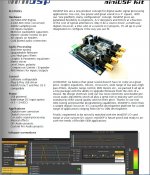
Hmm, looks like the sum and difference are gonna be my problem:
There are some mixers but they only do mix (+) [sum].
But they do have invert (-x) too ...


Is inverting, then summing the same as calcing the difference ? Sort of like regular algebra ?
x + (-y) = x - y

No problem here, it has:
From miniDSP 2-way adv plugin
Filter type
Selects the type and slope of the filter. The steeper the slope, the more quickly frequencies above or below the cutoff frequency are attenuated. There are three types of filter:
Butterworth (BW)
Available in 6, 12, 18, 24, 30, 36, 42, and 48 dB/octave, Butterworth crossover filters are 3 dB down at the cutoff frequency.
Linkwitz-Riley (LR)
Available in 12, 24, and 48 dB/octave, Linkwitz-Riley crossover filters are 6 dB down at the cutoff frequency.
for the 36dB Butterworth filter tuned to about 15Hz
and
Bessel
Available in 12 dB/octave only (whew!), a Bessel filter gives a more gradual roll-off through the crossover region...
for the
12dB bessel filter tuned to about 150Hz
Again issues with the sum and difference.
It does have biquads:
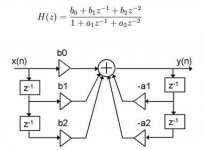
"Crossover advanced mode
The Crossover blocks have eight biquads on each output channel, allowing a high pass and low pass filter of up to 48 dB/octave ..."
and miniDSP also has a sweet biquad spreadsheet:
www.minidsp.com/images/fbfiles/files/All_digital_coefs_v1-20101026.zip
... but I don't know if I'm able to select two inputs or ...
:sratch1:
I figured you digital guys might know ...
Thanks,
Jeff

1. The mid to side converter. This turns Right and Left to R+L and R-L (or mid and side). Filter bypass options by a 3 way 4 pole rotary switch for stereo (Lbp and Rbp), and mono (Mbp).
Hmm, looks like the sum and difference are gonna be my problem:
There are some mixers but they only do mix (+) [sum].
But they do have invert (-x) too ...


Is inverting, then summing the same as calcing the difference ? Sort of like regular algebra ?
x + (-y) = x - y

2. Filters. A 36dB Butterworth filter tuned to about 15Hz for the R+L channel, as most of the lateral rumble is below audio frequency. A 12dB bessel filter tuned to about 150Hz for the R-L channel - the low group delay of the Bessel filter ensures that the frequency response won't be too bumpy . Also a stereo collapse option via the Mono/Stereo switch.
No problem here, it has:
From miniDSP 2-way adv plugin
Filter type
Selects the type and slope of the filter. The steeper the slope, the more quickly frequencies above or below the cutoff frequency are attenuated. There are three types of filter:
Butterworth (BW)
Available in 6, 12, 18, 24, 30, 36, 42, and 48 dB/octave, Butterworth crossover filters are 3 dB down at the cutoff frequency.
Linkwitz-Riley (LR)
Available in 12, 24, and 48 dB/octave, Linkwitz-Riley crossover filters are 6 dB down at the cutoff frequency.
for the 36dB Butterworth filter tuned to about 15Hz
and
Bessel
Available in 12 dB/octave only (whew!), a Bessel filter gives a more gradual roll-off through the crossover region...
for the
12dB bessel filter tuned to about 150Hz
3. Mid Side to Right and Left. Takes the filtered R+L (R+L f) and R-L (R-L f) and converts to Right and Left outputs using a summing amp and a difference amp.[/I]"
Again issues with the sum and difference.
It does have biquads:

"Crossover advanced mode
The Crossover blocks have eight biquads on each output channel, allowing a high pass and low pass filter of up to 48 dB/octave ..."
and miniDSP also has a sweet biquad spreadsheet:
www.minidsp.com/images/fbfiles/files/All_digital_coefs_v1-20101026.zip
... but I don't know if I'm able to select two inputs or ...
:sratch1:
I figured you digital guys might know ...
Thanks,
Jeff
Last edited:

Ah-ha! I think I found it.
In the miniDSP Rear/Center Plugin:
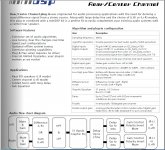
from:
View attachment Product Brief-Rear-Center channel plug-in.pdf
I'll just have to double-check the HP & LP and 31-band EQ filter blocks to make sure they can do:
36dB Butterworth, 15Hz for R+L
12dB bessel, 150Hz for R-L
Or something almost identical.

I have one of "these" in my preamp collection The Derumbleizer cancels rumble 3 octaves higher than any filter
I'm a fan of fully panned early stereo so not sure how the summed bass effects headphone listening with that type recording. My Bogen/Lenco B52 normally sounds like a freight train on lp- with the derumbleizer, there's just some obnoxious squeaky overtones
one thing I thought was cool but can't remember how it was done was to use feedback in a tube cascade pair to remove rumble. Christopher Paul did a writeup in Glass Audio on that circuit and I lost my tube diary which had a lot of tricks and circuits which I unfortunately did not commit to memory.
I'm a fan of fully panned early stereo so not sure how the summed bass effects headphone listening with that type recording. My Bogen/Lenco B52 normally sounds like a freight train on lp- with the derumbleizer, there's just some obnoxious squeaky overtones
one thing I thought was cool but can't remember how it was done was to use feedback in a tube cascade pair to remove rumble. Christopher Paul did a writeup in Glass Audio on that circuit and I lost my tube diary which had a lot of tricks and circuits which I unfortunately did not commit to memory.
Last edited:
- Status
- This old topic is closed. If you want to reopen this topic, contact a moderator using the "Report Post" button.
- Home
- Source & Line
- Analogue Source
- The ultimate rumble filter - far more effective than just a high pass filter!
